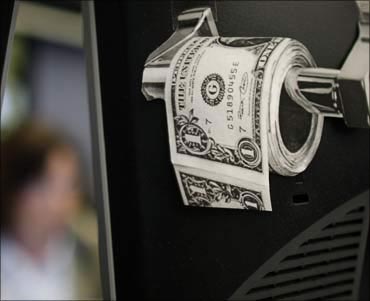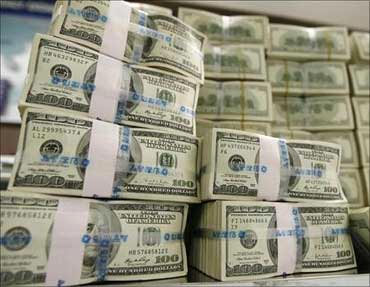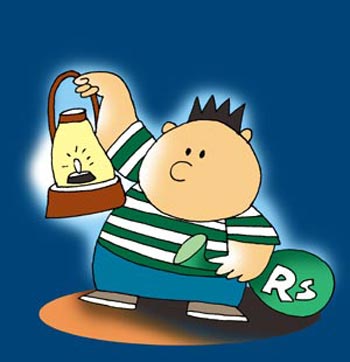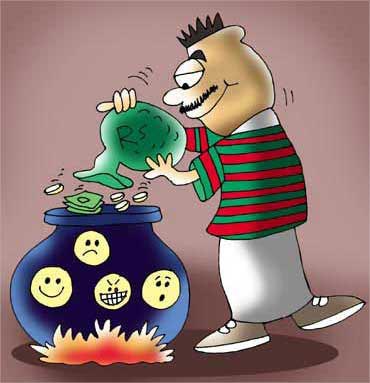 | « Back to article | Print this article |
Why Speak Asia seems to be like a Ponzi scheme
Plus ca change, plus c'est la meme chose, goes a French phrase, meaning 'the more things change, the more they remain the same'. This holds true in the case of Ponzi schemes as well.
Every few years a new one hits the market. Initial investors make money and the latter ones lose money.
Of late Speak Asia (www.speakasiaonline.com) has been in the news and is being investigated by various regulatory agencies of the government, including the ministry of corporate affairs.
Several investor protection groups have alleged that the company is nothing but another Ponzi scheme.
But before we go into that, let's first try and understand what a Ponzi scheme really is.
Click NEXT to read on . . .
Why Speak Asia seems to be like a Ponzi scheme
Double your money in 90 days!
Charles Ponzi, an Italian immigrant to the United States of America, promised this to investors way back in 1919. Born in Parma, Italy, in 1882, Ponzi, landed in the US in 1903.
In August 1919, in the process of issuing an export magazine, Ponzi realised that a huge arbitrage opportunity existed. Ponzi made an offer to a person in Spain requesting him to subscribe to an export magazine he planned to launch.
The subscriber sent Ponzi an international postal reply coupon, which could be exchanged at the local post office, for American stamps, needed to dispatch the magazine to Spain.
The coupon in Spain cost the equivalent of one cent in American currency. In America when Ponzi exchanged the coupon, he got six cents worth of stamps. Sensing the arbitrage opportunity, Ponzi decided to float an investment scheme.
Click NEXT to read on . . .
Why Speak Asia seems to be like a Ponzi scheme
So what was his modus operandi?
Ponzi promised investors that he could double their money in 90 days. Money started pouring in as no other investments in the market at that point in time offered such high returns.
Once the money had been collected, Ponzi planned to convert American dollars into foreign currency, buy international postal reply coupons from various countries, convert them into American stamps and sell them for a huge profit.
The idea was brilliant. But Ponzi had not taken into account the difficulties involved in dealing with various postal organisations around the world, along with other problems involved in transferring and converting currency.
Nevertheless, the investors got attracted to the huge returns the scheme promised.
How Ponzi went bankrupt
At its peak, the scheme had 40,000 investors who had invested around $15 million in the scheme. Meanwhile, Ponzi had started living an extravagant life blowing up the money investors brought in.
Click NEXT to read on . . .
Why Speak Asia seems to be like a Ponzi scheme
On July 26, 1920, the Boston Post ran a story questioning the legitimacy of the scheme. Within a few hours, angry depositors lined up at Ponzi's door, demanding their money back.
Ponzi asked his staff to settle their obligations. The anger subsided, but not for long. On August 10, 1920, the scheme collapsed. The auditors, the newspapers and the banks declared that Ponzi was definitely bankrupt.
It was revealed that only two stamps had been actually purchased. Money brought in by the new investors was used to pay off old investors.
So what is a Ponzi scheme?
A Ponzi scheme is essentially a fraudulent investment scheme where money brought in by the newer investors is used to pay off the older investors. This creates an impression of a successful investment scheme.
Of course, as long money entering the scheme is greater than the money leaving it, all is well. The moment the situation is reversed, the scheme collapses.
Click NEXT to read on . . .
Why Speak Asia seems to be like a Ponzi scheme
One Ponzi scheme differs from another, but despite the details changing, the structure abides. Here are some characteristics of Ponzi schemes:
The way the scheme plans to generate returns appears to be a genuine investment opportunity, but at the same time it is obscure enough to prevent any scrutiny by the investors.
Now, how does this characteristic work in case of Speak Asia? In order to become a member one has to invest Rs 11,000. This investment is essentially for subscribing to the electronic magazine issued by the company called Surveys Today.
Becoming a member also ensures your eligibility to participate in two online surveys per week, for which the company pays Rs 500 per survey or Rs 1,000 per week.
This when converted into a yearly number comes to Rs 52,000 (Rs 1,000 x 52). So an investment of Rs 11,000 ensures that you get Rs 52,000, which means a return of 373 per cent in one year. And this was basically the main selling point of the scheme.
Click NEXT to read on . . .
Why Speak Asia seems to be like a Ponzi scheme
The company also claimed that it had clients like ICICI Bank, Bata, Nestle, ING Vyasa Bank and Bharti Airtel for which the company carried out surveys, adding credibility to the whole scheme.
Of course, as it turned out later, Manoj Kumar, the chief executive of the India operations of the company, apologised for naming these companies as their clients.
"Taking the names of these organisations was a factual error on the part of our chief marketing officer Vivek Gautam and I apologise on behalf of Speak Asia," he told a press conference of journalists.
So basically the business model of the company, if there is one, is pretty vague, as is a characteristic of any successful Ponzi scheme.
In fact, the legal advisor of the company, Ashok Saraogi, said at a press conference: "The company is not selling any surveys to panellists but e-zines (electronic magazines) to its subscribers. Surveys are offered as additional benefit and can be withdrawn anytime if the company's contract with clients comes to an end."
Click NEXT to read on . . .
Why Speak Asia seems to be like a Ponzi scheme
Of course, this makes you wonder how can a magazine subscription cost Rs 11,000 per year? Over and above this, members also get money for enrolling new members, as is the characteristic of any Ponzi scheme.
Most of the Ponzi schemes start with an apparently legitimate or legal purpose.
Now there is nothing wrong in commissioning surveys, getting people to answer them and in turn paying them for it. This is an internationally accepted practise.
But the point is all the companies that Speak Asia claimed to have a relationship with them have denied having ever hired Speak Asia to carry out any survey.
Though Manoj Kumar said at the press conference that Speak Asia had worked on these brands, he also added the service was not commissioned by these institutions. Now go figure out what that means.
The most important part of a Ponzi scheme is assuring the investors that their investment is safe.
Click NEXT to read on . . .
Why Speak Asia seems to be like a Ponzi scheme
This is where the meeting of initial obligations becomes very important. Early investors become the most important part of the scheme. Ironically enough, in many cases it is their own money that is being returned to them.
Let us say an investor invests Rs 100 in a scheme that promises a return of Rs 20 in two months. So the scheme can easily survive for five months by returning the investor his own money. Also once the initial lot of investors have got their money back, the word spreads and more investors want to come into the scheme, which is essential for the survival of the scheme.
Now let us see how this characteristic works in the case of Speak Asia. Reports suggest that the company has around 19 lakh (1.9 million) members. Assuming that it has collected Rs 11,000 from each member, the company has managed to collect around Rs 2,090 crore (20.90 billion).
At a press conference recently, the company informed that it has distributed Rs 250 crore (Rs 2.50 billion) to its customers. How difficult can it possibly be to distribute Rs 250 crore when you have already collected around Rs 2,090 crore from your customers?
As they say, that is a no-brainer. Given the situation the company can keep running the scheme for a while given that it still has around Rs 1,840 crore (18.40 billion).
Click NEXT to read on . . .
Why Speak Asia seems to be like a Ponzi scheme
Also having paid out its initial lot of customers, as is characteristic to any Ponzi scheme, the company has managed to attract more and more customers.
The rate of return promised is high and is fixed at the time the investor enters the scheme. This ensures that the investor knows in advance what return he can expect from the scheme.
The twin combination of high and fixed returns helps attract more and more investors into the scheme. As customers worked it out in the case of Speak Asia, they would make Rs 52,000 on an investment of Rs 11,000.
The period between the investment and the pay out in a Ponzi scheme is short.
This ensures that the word spreads fast and more money comes in. Every additional investor gives legitimacy to such get-rich-quick schemes.
Speak Asia has done this as well. Payouts have been made fast, and this has given greater legitimacy to the scheme.
Click NEXT to read on . . .
Why Speak Asia seems to be like a Ponzi scheme
Brand-building is an inherent part of a Ponzi scheme.
The company has advertised big time in newspapers and magazines, and even on television channels. As the company said at the press conference, it has spent about Rs 50-60 crore (Rs 500-600 million) on advertising, public relations agency fees and brand-building.
All this adds credibility to Speak Asia as well.
It would thus seem that Speak Asia has the characteristics of a classic Ponzi scheme.
Readers need to remember that in a Ponzi scheme no new wealth is created. It is a classic zero-sum game. Wealth gained by participants entering the scheme earlier is the wealth lost by those coming in later.
Such a scheme can keep running only till the money entering the scheme is more than the money leaving the scheme. The most vulnerable investors are those who come at the end.
The author can be contacted on shonalee.biswas@gmail.com









